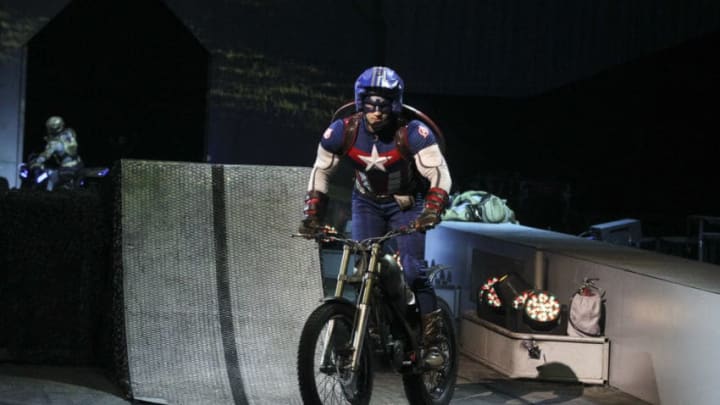Secret comic book movies: Captain America (1979)
By Mike McNulty

“But why? Brackett is no mad-dog killer.”
As for the aforementioned villains, this Captain America movie decides to trade-in the Nazis for that other bad guy staple, the corrupt business tycoon – more specifically, an evil oil tycoon named Lou Brackett (Steve Forrest) who was blackmailing Steve’s friend to steal plans for building a neutron bomb. Why does Brackett need a neutron bomb? So he can rob one of the largest gold reserves in the United States. Why does Brackett need to steal gold when he’s making tons of money in oil you might ask? Who knows? Because the movie certainly doesn’t explain it.
Another thing the movie doesn’t explain is how Brackett also knows all about the FLAG formula. In fact, the reason Brackett tries to have Steve killed is to prevent him from taking FLAG in the first place. Guess the joke’s on him since Steve had no intention of taking FLAG, but also because FLAG saves Steve’s life after the attempted murder by Brackett’s men. In other words, if Brackett had left Steve alone, then Steve wouldn’t have become the new Captain America – the very thing Brackett tried to prevent. It’s a desperate attempt to make what are otherwise villain-of-the-week baddies have a personal connection with the hero that, of course, falls flat.
“The American ideal. It’s a little tough to find these days, isn’t it?”
So if the characters are generic, two-dimensional cutouts and the plot has more holes than a gopher-infested lawn, surely the performances make up for it, right? Oh, you poor naïve souls. When it comes to Reb Brown, there’s a reason his credits are limited to television and B-movies. It’s because Brown has only three modes of acting: Saying his lines as if he’s reading the cue cards off-camera, flashing a goofy-looking smile, or yelling really, really loud.
[Captain America’s] powers…are so inspired by The Six Million Dollar Man and The Bionic Woman that there’s even a faux “bionic sound effect” whenever Steve uses his powers. At least Cap’s heroic theme, which blares anytime he first appears on his supped-up motorcycle, is catchy.
As for the other actors, their performances are mostly adequate but otherwise forgettable. The only one who seems to show any investment at all is Birman, and all he really does is deliver exposition, provide Steve with star-spangled gear and transportation, and all but begs him to “Be Captain America… shove it down their throats!”
As for that gear and transportation, you can tell most of the production budget went into the making of the Cap cycle, which does look sporty and slick. Cap’s signature shield also doubles as the bike’s windshield, thus making the white stripes and star clear. Yet this also betrays the fact that this “bulletproof” and “aerodynamic” weapon is an all-too-obvious over-sized, plastic Frisbee.
The first costume Steve wears (after an hour and fifteen minutes in), looks pretty ridiculous, too. Nor does it resemble what Cap wears in the comics. As I said, that doesn’t happen until the end, and it actually looks worse. In both costumes, Cap’s winged mask with the “A” emblem is really a motorcycle helmet. I guess the costume designer thought it would look cool and practical in theory, but it just adds to the silliness.
More from Marvel TV
- Loki season 2 finale does set the stage for Kang Dynasty
- Marvel rumors hint Pedro Pascal has been cast in key Fantastic Four role
- Loki season 2: All 6 episodes ranked from worst to best
- Dear Marvel: Here’s how to fix the Kang problem
- Loki season 2 episode 5 release time (by time zone)
All of this would be forgivable if Captain America wasn’t so dull. There’s action, of course, but it’s of a generic variety even with Steve’s supposed superpowers. Those powers, which includes not only enhanced strength and agility but also supervision and hearing, are so inspired by The Six Million Dollar Man (1973-1978) and The Bionic Woman (1976-1978) that there’s even a faux “bionic sound effect” when Steve uses his powers. At least Cap’s heroic theme, which blares anytime he first appears on his supped-up motorcycle, is catchy.
Still, for as much as I’ve criticized this movie, Captain America does have some charm within its schlock. We must also realize that, for the longest time, this was the only live-action version of the Sentinel of Liberty that fans had. Even now, you can still buy it on DVD, Blu-Ray, YouTube, Amazon Prime, and Hulu. As this also saw a theatrical release, albeit only in Columbia, you could say this was years before Captain America: The First Avenger (2011) the most successful Cap film of all time. It may not have resulted in an ongoing television series as intended, but it still got a sequel.
Next. Secret comic book movies: The Amazing Spider-Man TV pilot (1977). dark
We’ll be tackling that one eventually. For next time, however, we’ll be looking one more TV pilot of a Marvel Comics character launched in the 1970s, but one not as successful as The Incredible Hulk, Amazing Spider-Man, or even Captain America. You might say it’s a bit… Strange.